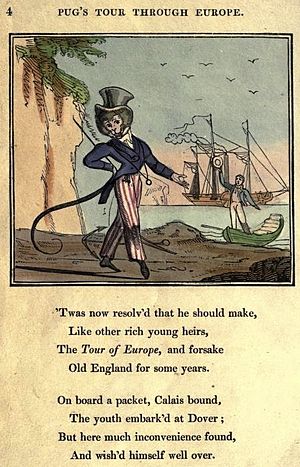John Harris (publisher) facts for kids
John Harris (1756–1846) was an important publisher of children's books in England. He published many popular and new kinds of books from 1802 until the mid-1800s. He built on the ideas of John Newbery and Elizabeth Newbery, who were famous for their children's books in the 1700s.
Harris first worked for other publishers like Thomas Evans and John Murray. Later, he joined the Newbery family's publishing business.
Contents
A New Start in Children's Books
In 1802, John Harris bought Elizabeth Newbery's company. For many years, he used the name "successor to E. Newbery" to show he was continuing her work. Elizabeth Newbery had hired Harris in 1797.
Fun Over Lessons
In 1805, Harris published a very special book called The Comic Adventures of Old Mother Hubbard and Her Dog. This book was different from others at the time. Most children's books tried to teach lessons, but Mother Hubbard was just for fun! It was meant only to make children laugh.
The first edition of Mother Hubbard had many detailed pictures. Each page had a picture made from a copperplate engraving. This was different from the simple woodcut pictures used before. The book was also quite small, about 4 by 5 inches.
Mother Hubbard sold very well. Its success led Harris to publish more similar books. These included Whimsical Incidents in 1805 and a colourful edition of John Gilpin a year later.
More Popular Books
In 1807, Harris published The Butterfly's Ball, which was also a huge success. This led to many similar books. He also published some cautionary tales, like The Cowslip.
That same year, he started a series called Harris' Cabinet of Amusement and Instruction. These stories were made to entertain children. This was different from authors like Sarah Trimmer, who wrote only to teach. By 1809, Harris had a huge list of 419 different books for sale.
Growing the Business
In 1819, the company became J. Harris & Son. At this time, they started making new, colourful versions of books that had only been in black and white before. These books were quite expensive for the time. A plain book cost one shilling, and a coloured one cost eighteen pence.
By the end of the Regency era (around 1820), Harris was one of the most important publishers of children's books in London. Not everyone loved his work, though. One of his books of tongue twisters was called "degrading trash." Some reviewers also said his colourful pictures were "gaudy glare." But even with these criticisms, his books continued to sell well and were very popular.
Fairy Tales and Education
Back then, many English laws were against fairy tales. So, English publishers often brought in fairy stories from France and Germany. John Harris published a book of fairy tales in 1802 called Mother Bunch's Fairy Tales.
In 1820, his company published The Court of Oberon; or, The Temple of Fairie. This book was very important for children's literature. It included stories from famous writers like Charles Perrault and Madame d'Aulnoy, as well as tales from The Arabian Nights. This book came out the same year that the Brothers Grimm's famous collection of tales was translated into English.
Harris's company also published educational books. For example, Pug's Tour Through Europe; or, The Travell'd Monkey (1824) was written "by Himself." This book had verses and hand-coloured pictures. It was educational but also a funny satire of how gentlemen used to travel around Europe. It playfully showed ideas about British culture.
New Printing Methods and Legacy
In the 1820s, the company started using hand-coloured woodcuts. These made the pictures even more colourful than the earlier copperplate illustrations.
In 1824, John Harris handed the business over to his son. Later, in 1843, the company was bought by Grant and Griffith. John Harris passed away three years later, in 1846. His work greatly shaped children's books, making them more fun and colourful.



